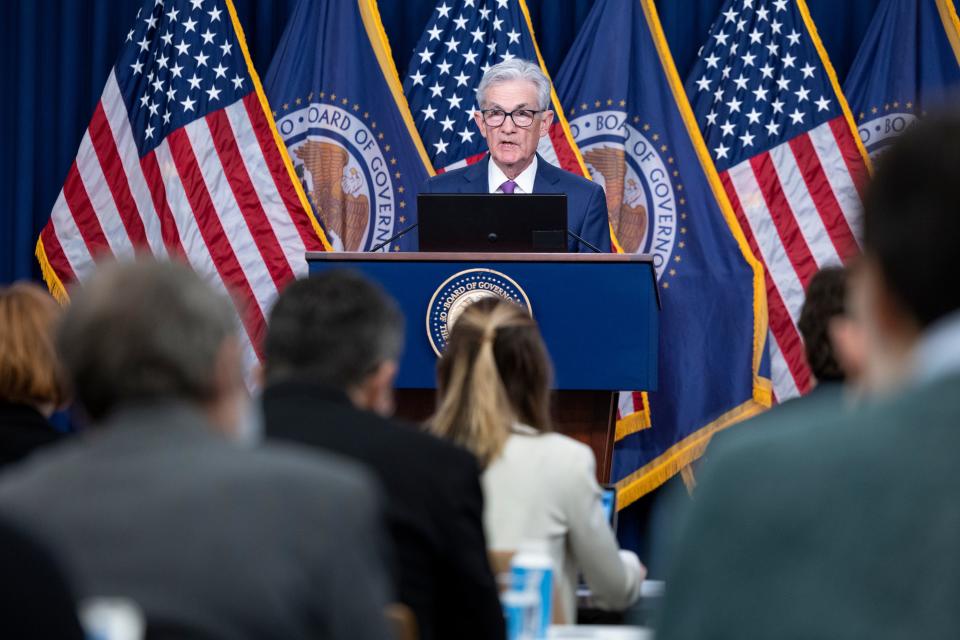Fed likely to hint interest rates will stay higher for longer. But how high for how long?
The Federal Reserve meets this week for the first time since recent high inflation readings dampened hopes that the central bank would lower interest rates three times this year.
The prospect of three rate cuts had juiced the stock market and led analysts to boost their 2024 economic growth forecasts.
Though stocks initially tumbled following the disappointing inflation reports, they’ve partly rebounded the past week on strong earnings from Big Tech companies.
At the close of a two-day meeting that starts Tuesday, the Fed was expected to keep its key short-term interest rate unchanged at a 23-year high of 5.25% to 5.5%. Fed officials aren’t scheduled to update their March forecasts on the economy, inflation and rates. But Fed Chair Jerome Powell could provide clues on where he thinks interest rates are headed.
Fed meeting live updates:: What's next for interest rates?

Here's a breakdown:
Is inflation increasing right now?
Inflation eased substantially last fall. After hitting a 40-year high of 9.1% in mid-2022, annual inflation fell from 3.7% to 3.1% in the second half of 2023, and a core measure that strips out volatile food and energy items dipped below 4%, according to the consumer price index (CPI).
But prices jumped each month in the first quarter of 2024, leaving yearly inflation at 3.5% in March and the core measure at 3.8%.
Another inflation gauge called the personal consumption expenditures index (PCE) – which the Fed watches more closely - followed a similar pattern, though it’s running about a percentage point lower. Overall inflation is at 2.7% and the core measure is at 2.8%, still well above the Fed’s 2% goal, according to the PCE.
Why did inflation slow down last year?
The price of used cars, furniture and other goods dropped as pandemic-related supply chain bottlenecks resolved.
Why has inflation recently risen so high?
The cost of services such as rent, car insurance and health care has continued to climb sharply, partly because of rising wages linked to COVID-19-induced labor shortages.
What does Jerome Powell say about inflation?
Initially, Powell said price increases in January and February simply could have been blips on a steady path to 2% inflation. And Fed officials’ forecast for three rate cuts this year remained intact. But after CPI and PCE reports last month showed that prices surged again in March, Powell took a different tone.
“The recent data have clearly not given us greater confidence (that inflation is heading sustainably to 2%) and instead indicate that it’s likely to take longer than expected to achieve that confidence,” he said at a forum a couple of weeks ago.
Futures markets that had projected the first rate cut in June and a total of three decreases in 2024 now predict just one cut in September.
Is inflation easing?
Most economists believe it is. Goldman Sachs says the recent flare-up can be traced to temporary factors. Rent, which made up 36% of March’s price surge, actually has fallen based on new tenant leases, but that hasn’t yet rippled to existing lease renewals.
Car insurance, which has soared 22% in the past year, is still catching up to a COVID-19-related leap in new vehicle prices as state regulators approve rate hikes. With vehicle prices flat or falling, insurance premium increases should soon moderate, Goldman says.
And financial service costs vaulted higher because portfolios were increasing in value during the market rally and investment company fees are typically based on a percentage of assets. But the rally recently has sputtered.
Meanwhile, wage growth is slowing as the labor market cools and immigration expands the supply of workers, a development that should curtail price increases, Goldman says. It expects core PCE inflation to slip to 2.6% by July.
Barclays broadly agrees and expects inflation to slow notably starting in June. But the cost of some services, such as dining out and haircuts, could continue to advance more sharply as pay increases stay elevated in some industries due to lingering labor shortages, Barclays says. It reckons core PCE inflation will tick up to 2.9% by December.
Goldman expects two rate cuts, in July and November, though the research firm acknowledges the risk that stubborn inflation could limit or even delay cuts to 2025 or beyond. Barclays anticipates just one cut in September.
So what will Powell say on Wednesday?
Both Goldman and Barclays expect Powell to reiterate his comment that it will “likely take longer than expected to achieve that greater confidence” needed to cut rates.
Barclays economist Marc Giannoni doesn’t expect him to “be very specific about the number of cuts” since Fed officials aren’t updating their forecasts and Powell has said Fed decisions will hinge on the course inflation takes in coming months.
Rent or buy? Big-city dwellers are better off renting than buying a home everywhere, analysis says
But Powell could downplay the relevance of the Fed’s March forecasts, signaling that three rate cuts aren’t likely, Giannoni says.
Nationwide economist Oren Klachkin figures the Fed chief won’t tip his hand.
“I think he’ll leave the door open,” he says. “I think (Fed officials) still very much want to cut rates” now that inflation is slowing and the risks that high rates pose to a cooling job market are growing.
This article originally appeared on USA TODAY: Fed rates likely to stay higher for longer

 Yahoo Finance
Yahoo Finance 